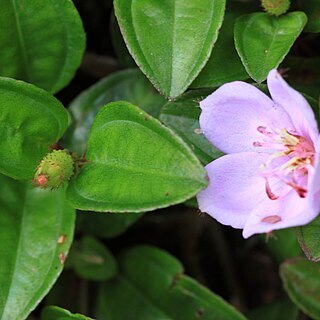Shrublets 10-30 cm tall. Stems often repent; branchlets numerous, procumbent, strigose when young, later glabrous. Petiole 0.2-0.6(-1.5) cm; leaf blade ovate to elliptic, 1-4 × 0.8-2(-3) cm, stiffly papery, abaxially very remotely strigose along veins, adaxially usually strigose at margin only or sometimes sparsely strigose among veins, secondary veins 1 or 2 on each side of midvein, tertiary veins numerous and parallel, base broadly cuneate, margin densely serrulate or entire, apex acute. Inflorescences terminal, cymose, (1-)3-flowered, with 2 leaflike bracts at base. Pedicel 2-10 mm, strigose, apically 2-bracteolate; bracteoles ovate, 2-3 × ca. 1.5 mm, abaxially strigose, margin ciliate. Hypanthium ca. 5 mm, strigose, base of trichomes conically inflated. Calyx lobes lanceolate, 2-3 mm, sparsely strigose, margin bristly ciliate. Petals lavender to purple, rhomboid-obovate, 1.2-2 × 1-1.5 cm, apically oblique. Longer stamens with purple anthers; connective long extended at base, curved, apex 2-tuberculate. Shorter stamens with connective not extended, apex 2-tuberculate. Ovary inferior, apically bristly. Fruit urceolate-globular, 7-9 × ca. 7 mm, succulent, strigose. Fl. May-Jul, fr. Jul-Sep.
More
A creeping herb. It keeps growing from year to year. The base of the stem is woody. The young portions are hairy. The leaves are opposite and broadly oval. They are 1-5 cm long by 1-2 cm wide. The flowers are purple-pink. They are 3 cm across. They bloom only in sunshine. There are 1-in groups at the ends of branches. The fruit are round and purple. They are like berries and 7-10 mm across. They are sweet and juicy.
Virgin wilds on hillsides. Open fields, grassland, trailsides and thickets to elevations of 1300 metres in. Anhui, Fujian, Guizhou, Guangdong, Guangxi, Hunan, Jiangxi and Zhejiang Provinces.
More
It is a temperate plant. It grows on dry slopes and bare rocks. In China it grows in open fields and grasslands below 1,300 m above sea level.
Open, dry or wet grassland and scrub; at elevations up to 800 metres.


